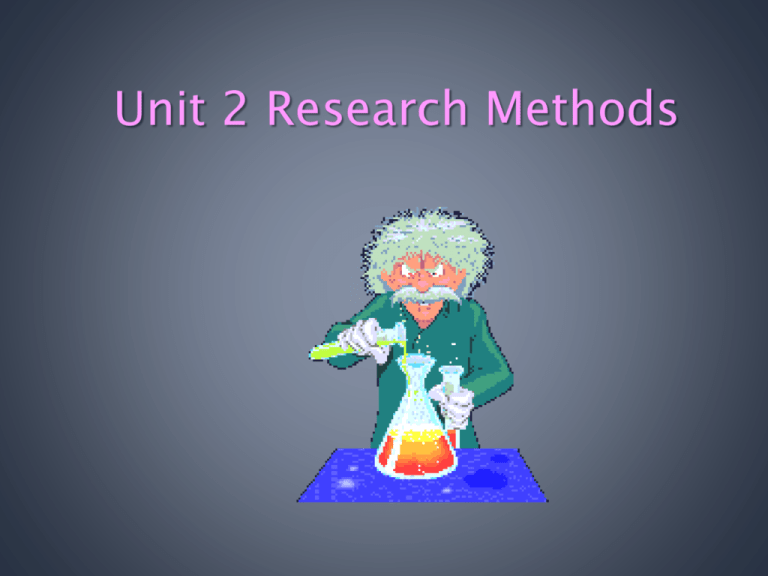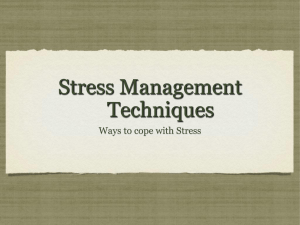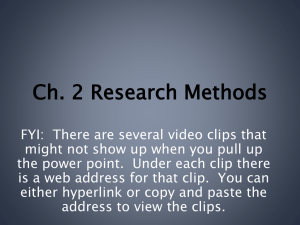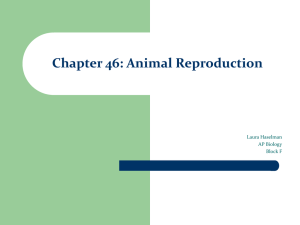Ch. 2 Research Methods
advertisement

Unit 2 Research Methods Goals of Psychological Research • Description of social behavior – Are people who grow up in warm climates different from those in cold climates? • Establish a relationship between cause & effect – Does heat cause higher amounts of aggression? • Develop theories about why people behave the way that they do – We dislike Duke students to feel better about ourselves • Application – Creating effective therapeutic treatments, more successful negotiation tactics, and greater understanding amongst groups of people Scientific Method Create testable operational definitions Be curious. Question your world. Collect data using DESCRIPTIVE Research Conduct more research Naturalistic Observation Survey Case Study Form a Hypothesis Relationship? CORRELATION Causation? EXPERIMENT Doesn’t support the hypothesis Continue to retest Use this to predict and explain the world Supports the hypothesis Create a Theory Unit 2 Research Methods Psychology is first and foremost a science. It is Empirical. It is based on research. Before we delve into how to do research, you should be aware of three hurdles that tend to skew our logic. Hindsight Bias Hindsight bias is the tendency to think that past events were more predictable than they actually were. Knowing about hindsight bias is useful in two ways: Firstly, it gives you something to say when your parents accuse you of failing to predict an event. You can accuse him of having hindsight bias.(Well, it's better than saying "Yeah, we know that now!") Overconfidence We tend to think we know more than we do The Barnum Effect • It is the tendency for people to accept very general or vague characterizations of themselves and take them to be accurate. Hawthorne Effect • Just knowing you are participating in a study can change the outcome. Just the fact that you know you are in an experiment can cause change. http://www.propagandaposters.us/poster11.html Experimenter Bias • “Did you study for your test?” • “MMMM.. I think he wants me to say yes?!?” Terms used in Research: Hypothesis: is a testable prediction that lets us accept, reject or revise a theory. If families do not stress gender differences then there will be fewer sex differences in siblings. http://www.google.com/imgres?imgurl=http://www.simplypsychology.pwp.blueyonder.co.uk/hypothesis.jpg&imgrefurl=http://www.simp lypsychology.pwp.blueyonder.co.uk/aimshypotheses.html&usg=__NRh_zDntHhH4hvdURWKWFOXauEI=&h=384&w=428&sz=19&hl=en&start=0&zoom=1&tbnid=toLUNv3BSvDUhM:&tbnh=123&tbnw=137&prev=/images%3Fq%3Dhypothesis%26um%3D1%26hl%3Den%26sa%3DN%26rlz%3D1T4ADRA_enUS376US377%26biw%3D1899%26bih%3D922%26 tbs%3Disch:1&um=1&itbs=1&iact=rc&dur=193&ei=qCyETKj7FZCgsQPilPytCw&oei=qCyETKj7FZCgsQPilPytCw&esq=1&page=1&ndsp=38&ved=1t:429,r:1,s:0&tx=54&ty=87 Theory •Aims to explain http://www.youtube.com/watch?v=cbEKAwCoCKw • Experimental Group: Receives Treatment • Control Group: receives no treatment Operational Definitions • Explain what you mean in your hypothesis. • How will the variables be measured in “real life” terms. • How you operationalize the variables will tell us if the study is valid and reliable. Let’s say your hypothesis is that chocolate causes violent behavior. • What do you mean by chocolate? • What do you mean by violent behavior? Variables http://tytusblog.blogspot.com/2009/08/engineers-make-better-models-of.html are what you are manipulating in your experiment. • Placebo: “sugar pill” that is given and the patient believes to be the real thing. SHHHHHHH This lady thinks she has been given and antidepressant but really she only got a placebo. Independent Variable • Whatever is being manipulated in the experiment. • Hopefully the independent variable brings about change. If there is a drug in an experiment, the drug is almost always the independent variable. Dependent Variable • Whatever is being measured in the experiment. • It is dependent on the independent variable. The dependent variable would be the effect of the drug. Beware of Confounding Variables If I wanted to prove that smoking causes heart issues, what are some confounding variables? • The object of an experiment is to prove that A causes B. • A confounding variable is anything that could cause change in B, that is not A. Lifestyle and family history may also effect the heart. Double Blind vs. Single Blind Types of Research Methods Types of Correlation Positive Correlation • The variables go in the SAME direction. Negative Correlation • The variables go in opposite directions. Studying and grades hopefully has a positive correlation. Heroin use and grades probably has a negative correlation. Statistics • Recording the results from our studies. • Must use a common language so we all know what we are talking about. Descriptive Statistics • Just describes sets of data. • You might create a frequency distribution. • Frequency polygons or histograms. Validity and Reliability •Valid:it is accurate • Reliable: It can be replicated Central Tendency • Mean, Median and Mode. • Watch out for extreme scores or outliers. Let’s look at the salaries of the employees at Dunder Mifflen Paper in Scranton: $25,000-Pam $25,000- Kevin $25,000- Angela $100,000- Andy $100,000- Dwight $200,000- Jim $300,000- Michael The median salary looks good at $100,000. The mean salary also looks good at about $110,000. But the mode salary is only $25,000. Maybe not the best place to work. Then again living in Scranton is kind of cheap. Normal Distribution • In a normal distribution, the mean, median and mode are all the same. Distributions • Outliers skew distributions. • If group has one high score, the curve has a positive skew (contains more low scores) • If a group has a low outlier, the curve has a negative skew (contains more high scores) Other measures of variability • Range: distance from highest to lowest scores. • Standard Deviation: the variance of scores around the mean. Shaq and Kobe may both score 30 ppg (same mean). • The higher the variance or SD, the But their SDs are very different. more spread out the distribution is. • Do scientists want a big or small SD? Scores • A unit that measures the distance of one score from the mean. • A positive z score means a number above the mean. • A negative z score means a number below the mean. Experimental vs. Control Group Pg. 40 Self-Fulfilling Prophesy http://www.youtube.com/watch?v=nOSNGKYKgX4 Methods of Research Types of Research • Descriptive • Correlational • Experimental Experimental Method pg. 39 http://www.youtube.com/watch?v=6EjJsPylEOY • Done in a lab. • Good: You have control over your environment. Naturalistic Observation The bad is that we can never really show cause and effect. http://www.youtube.com/watch?v=fSiWXkOfHBY&feature=related Good: Let’s you observe in a participants natural setting. There is Hawthorne effect. http://www.youtube.com/watch?v=e66XKxT8yDY Case Studies An intense study of a person or group. Diaries, Tests, and interviews. The Case Study • Where one person (or situation) is observed in depth. What are the strengths and weaknesses of using a tragedy like the Columbine School Shootings as a case study? Survey Says… http://www.youtube.com/watch?v=iejf3YZboQ8 • We like Survey’s because: – 1. They are cheap – 2. you can get a large amount of information quickly. We don’t like Survey’s because: 1. Danger of participants putting the wrong answers. Survey Method: The Bad • Low Response Rate • People Lie or just misinterpret themselves. • Wording Effects How accurate would a survey be about the use of drugs in school? Why do we sample? • One reason is the False Consensus Effect: the tendency to overestimate the extent to which others share our beliefs and behaviors. Sampling • SAMPLE is a group of participants that represent a POPULATION six-sigma-material.com http://mips.stanford.edu/courses/stats_data_analsys/lesson_1/234_0_a.html A BAD SAMPLE Finding the average height of men or women by using basketball players for your sample. Longitudinal Studies http://www.google.com/imgres?imgurl=http://www.cfr.nichd.nih.gov/images/children_linedup2.jpg&imgrefurl=http://www.cfr.nichd.nih.gov/longitudinal.html&usg=__w_lHT2 -TFLy8l_gLnyOF-8W7ctE=&h=364&w=589&sz=68&hl=en&start=0&zoom=1&tbnid=J01pJhEZ4AmeM:&tbnh=99&tbnw=160&prev=/images%3Fq%3Dlongitudinal%2Bstudies%26um%3D1%26hl%3Den%26sa%3DN%26rlz%3D1T4ADRA_enUS376US377%26biw%3D1899%26bih%3D92 2%26tbs%3Disch:1&um=1&itbs=1&iact=rc&dur=334&ei=OheETPijDIn4swPDutH2Bw&oei=OheETPijDIn4swPDutH2Bw&esq=1&page=1&ndsp=37&ved=1t:429,r:10,s:0&tx=61&ty= 59 Data is taken from a group over a period of time. Cross-Sectional Studies • Data is collected from groups of individuals of different ages and compared. http://www.google.com/imgres?imgurl=http://goodhealth.freeservers.com/Indonesia_kids_smoking.jpg&imgrefurl=http://snusnews.blogspot.com/2009_06_07_archive.html&usg=__oeZOXLzTwb1zO0kgdosS5qe_rCU=&h=351&w=468&sz=29&hl=en&start=132&zoom=1&t bnid=229vf0XnoqVSUM:&tbnh=116&tbnw=152&prev=/images%3Fq%3Dkids%2Bsmoking%26um%3D1%26hl%3Den%26sa%3DN%26rlz%3D1T4ADR A_enUS376US377%26biw%3D1899%26bih%3D922%26tbs%3Disch:10%2C1185&um=1&itbs=1&iact=hc&vpx=1059&vpy=534&dur=2485&hovh=19 4&hovw=259&tx=140&ty=90&oei=wjGETOCOAYjksQOO1pj3Bw&esq=undefined&page=5&ndsp=36&ved=1t:429,r:7,s:132&biw=1899&bih=922 http://www.google.com/imgres?imgurl=http://www.lindsayheller.com/wp-content/uploads/2010/01/cigar_smoking_oldladies_0.jpg&imgrefurl=http://www.lindsayheller.com/%3Fpaged%3D11&usg=__FkMm0dRST9c9tJNK7B_LT22sqOE=&h=580&w=704&sz=70&hl=en&s tart=0&zoom=1&tbnid=JbiB_M2_DPBkCM:&tbnh=110&tbnw=133&prev=/images%3Fq%3Dold%2Bpeople%2Bsmoking%26um%3D1%26hl%3Den%26sa% 3DN%26rlz%3D1T4ADRA_enUS376US377%26biw%3D1899%26bih%3D922%26tbs%3Disch:1&um=1&itbs=1&iact=rc&dur=324&ei=wzKETN_CJI6isQOv3 oD3Bw&oei=wzKETN_CJI6isQOv3oD3Bw&esq=1&page=1&ndsp=40&ved=1t:429,r:12,s:0&tx=124&ty=46 http://www.google.com/imgres?imgurl=http://www.babble.com/CS/blogs/strollerderby/image141306x.jpg&imgrefurl=http://www.babble.c om/CS/blogs/strollerderby/archive/tags/teen%2Bsmoking/default.aspx&usg=__NXRN3isiMRxtCylaCFg0QXJdIU=&h=278&w=370&sz=21&hl=en&start=0&zoom=1&tbnid=B1brJTNGGuPE1M:&tbnh=114&tbnw=156&prev=/images%3Fq%3Dte ens%2Bsmoking%26um%3D1%26hl%3Den%26sa%3DN%26rlz%3D1T4ADRA_enUS376US377%26biw%3D1899%26bih%3D922%26tbs%3Disch:1&u m=1&itbs=1&iact=hc&vpx=280&vpy=102&dur=349&hovh=195&hovw=259&tx=248&ty=96&ei=NTKETLKbOISesQPTo_z2Bw&oei=NTKETLKb OISesQPTo_z2Bw&esq=1&page=1&ndsp=37&ved=1t:429,r:1,s:0 Correlational Research • The correlation technique indicates the degree of association between 2 variables • Correlations vary in direction: – Positive association: increases in the value of variable 1 are associated with increases in the value of variable 2 – Negative association: increases in the value of variable 1 are associated with decreases in the value of variable 2 – No relation: values of variable 1 are not related to variable 2 values © 2004 John Wiley & Sons, Inc. Huffman: PSYCHOLOGY IN ACTION, 7E Correlation pg. 39 The measure of a relationship between two variables = This would be a positive correlation • Correlation • Weight Gain Drinking Café Mochas from Dakotas everyday = This would be a negative correlation Correlations • Correlations also vary in the strength of the association – Zero correlation: no relationship between the 2 variables – Strong correlation: knowing the value of one variable permits one to accurately estimate the value of the other variable • Strong correlation can be positive or negative • Correlations can be seen in scatter plots © 2004 John Wiley & Sons, Inc. Huffman: PSYCHOLOGY IN ACTION, 7E Correlation Difficulties © 2004 John Wiley & Sons, Inc. Huffman: PSYCHOLOGY IN ACTION, 7E Correlational Research • Detects relationships between variables. • Does NOT say that one variable causes another. There is a positive correlation between ice cream and murder rates. Does that mean that ice cream causes murder? Measured using a correlation coefficient. • A statistical measure of the extent to which two factors relate to one another How to Read a Correlation Coefficient Why do we have Ethical Guidelines? During WWII the Nazi’s conducted some very unethical studies. Many of their subjects died during theses experiments. What you need to know is: 1. These people were denied the principles in the Belmont Report including being asked to participate. • Milgram Study (1963): The Milgram study involved instructing subjects to administer electric shocks to a study confederate in response to poor performance. The subject believed that he/she was involved in a study about learning and memory with each shock intended to affect the learning process. The confederate pretended to be hurt by the shock - in some cases, to the point of losing consciousness; however, he/she did not really feel any shock. The study objective was to assess obedience to authority. This study resulted in significant psychological stress for some subjects including sweating, trembling, stuttering and serious seizures in three subjects. However, in a postexperimental interview, about half of the subjects expressed that they were glad to have participated in the experiment. The question of whether this study was ethical remains open to debate among scholars today. • Stanford Experiment • A group of men volunteered for a study and were given the roles of prisoners or guards. In a short time the guards took it upon themselves to start trouble with the prisoners and the experiment got out of hand. Lesson in “the Lucifer” Effect. How good guys turn bad. Ethical Issues in Research • Respecting the rights of human research participants involves: – Informed consent is an explanation of a study and the responsibilities of experimenter and participant – Deception involving the subjects must be justified – Confidentiality of study information must be maintained – Debriefing refers to explaining the research process to the subjects at the end of the study • Animal research must be justified and must minimize discomfort to participants © 2004 John Wiley & Sons, Inc. Huffman: PSYCHOLOGY IN ACTION, 7E • Who has to approve ALL research??? •IRB • Institutional Review Board (IRB) Statistics • A branch of math that summarizes and makes meaningful inferences from the data. http://www.google.com/imgres?imgurl=http://pix.motivatedphotos.com/2009/8/26/633868570471027490STATISTICS.jpg&imgrefurl=http://www.motivatedphotos.com/%3Fid%3D34720&usg=__v2u198pP5mA5uxBs2v5cCmV4Szo=&h=600&w=800&sz=70&hl=en&start=70&zoom=1& tbnid=b5h6z3gr0US9OM:&tbnh=123&tbnw=163&prev=/images%3Fq%3Dstatistics%2Bfunny%26um%3D1%26hl%3Den%26sa%3DN%26rlz%3D1T4ADRA_enUS376US377%26biw%3D 1899%26bih%3D922%26tbs%3Disch:10%2C663&um=1&itbs=1&iact=hc&vpx=1286&vpy=376&dur=2777&hovh=194&hovw=259&tx=140&ty=91&oei=QPuETPNJhNa1A7qDrPYH &esq=3&page=3&ndsp=34&ved=1t:429,r:19,s:70&biw=1899&bih=922 Normal Distribution Mode Statistics the most frequently occurring score in a distribution Mean the arithmetic average of a distribution obtained by adding the scores and then dividing by the number of scores Median the middle score in a distribution half the scores are above it and half are below it Statistics Range the difference between the highest and lowest scores in a distribution Standard Deviation a computed measure of how much scores vary around the mean Statistical Significance a statistical statement of how likely it is that an obtained result occurred by chance Illusory Correlations • Redelmeier and Tversky (1996) assessed 18 arthritis patients over 15 months, while also taking comprehensive meteorological data. Virtually all of the patients were certain that their condition was correlated with the weather. • In fact the actual correlation was close to zero. • Usually when the data in question stands out • Ice cream sales and the number of shark attacks on swimmers are correlated. • Skirt lengths and stock prices are highly correlated (as stock prices go up, skirt lengths get shorter). • The number of cavities in elementary school children and vocabulary size are strongly correlated.








